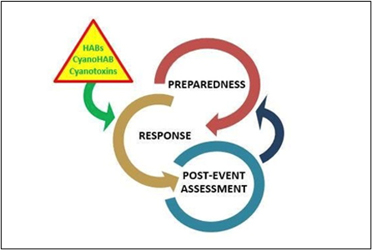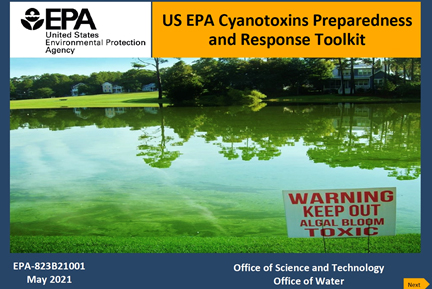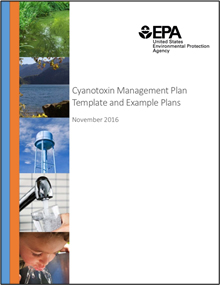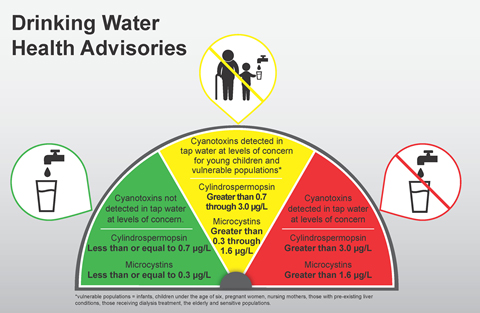New Toolkit Arrives Just In Time For HAB Season


With harmful algal blooms (HABs) being forecast to increase, in part due to the effects of climate change, more water systems can expect to face problematic cyanotoxin conditions more frequently and for more days per year. In its efforts to mitigate the negative effects of such increases, the U.S. EPA has enhanced its information resources for water utilities by issuing a new Cyanotoxins Preparedness and Response Toolkit (CPRT) (Figure 1).

Source: US EPA Cyanotoxins Preparedness and Response Toolkit
Figure 1
According to the EPA website, “The Cyanotoxins Preparedness and Response Toolkit (CPRT) is an online tool to help states and tribes prepare for potential HABs in freshwater bodies and know how to respond to protect public health. The CPRT follows the EPA’s National Response Framework (NRF), a consistent nationwide framework built on the Department of Homeland Security’s National Incident Management System (NIMS). As such, the CPRT includes the essential components to prevent and respond to cyanotoxin events in drinking and recreational waters, and to update and improve preparedness and response for future cyanotoxin events.”
Forewarned Is Forearmed
The themes behind the CPRT are awareness and readiness — for actions that states, tribes, municipalities, and water systems can take before, during, and after HAB events. It encompasses:
- FAQs about HABs, drinking water advisories, and recreational water guidelines,
- regulatory requirements around HABs and cyanotoxins, and
- a wide range of information relating to situation guidelines, management and communication plans, and online resources for addressing cyanotoxin concerns related to HAB incidents.
Just one of the many resources included is the EPA’s 199-page Cyanotoxin Management Plan Template and Example Plans (EPA 810-B-16-006), which highlights management plans from five different water systems (Figure 2).

Source: EPA 810-B-16-006
Figure 2. This informative document referred to in the CPRT includes a 32-page template for a cyanotoxin management and communications plan that any water utility or health department can use to establish its own framework for addressing local HAB cyanotoxin events. It also includes sample management plans for five different water systems serving populations ranging from just over 3,000 to more than a quarter-million residents.
A Step-By-Step Playbook
The impacts of HAB threats and their potential disruptions on public water systems make it worthwhile for all utilities to evaluate their risks and assess their plans for action — particularly if they have not yet experienced HAB events. The CPRT offers guidance on how to do so across these specific areas:
- Waterbody Vulnerability Assessment. Knowing HAB contributing influences and weighing the vulnerability of given water sources can help utilities evaluate their relative levels of risk and prepare for likely challenges in advance.
- Preparation And Surveillance For HAB Events. Establishing a good source-monitoring program, methodically testing water supplies, and recording results can help utilities gain greater insight on the behavior of their waterbody sources in advance of potential problems. Being prepared to trigger specific actions as cyanotoxin levels reach detectable levels can put a utility or health department in a position to mitigate the negative effects of an actual cyanotoxin event, if and when it eventually occurs. While drinking-water and recreational-water applications can share common risks in a given waterbody, drinking-water applications require more comprehensive testing — extending through the finished-water stage of treatment.
- Communicating HAB Events To The General Public. Even before a HAB event does occur, it is important to recognize the scope of impact on the public and to be prepared with timely advisories and clearly communicated messages designed to inform them of the status, potential risks, and appropriate precautions around the event (Figure 3). These will be different in the case of recreational vs. drinking water impacts.
- Municipal/Utility Actions. Prepare all involved employees for their roles in monitoring, reacting to, and communicating appropriate messages to impacted parties. These include field-testing personnel, lab specialists, treatment-plant operators, utility-management or customer-service personnel, and public health officials.
- Completing The Cycle. Taking time to reassess HAB incidents after they have run their course can help impacted utilities and municipalities identify shortcomings — in terms of detection, risk assessment, mobilization, response strategy, coordination, and public communications — to help them be better prepared for future events.

Source: EPA Drinking Water Cyanotoxin Risk Communication Toolbox Graphics
Figure 3. The CPRT provides many support materials for municipal and drinking-water-utility internal management actions and for communicating risks to drinking-water customers and recreational swimming enthusiasts — including colorful graphics such as this.
Guidance For Locally Impacted Events
The wealth of links included within the CPRT provide specific reference materials that can be helpful to any water utility or municipal health department facing a potential HAB event — particularly those who have not yet lived through the experience. Categories of interest include links to:
- Rules and Regulations. Links to regulatory references include the Safe Drinking Water Act (SDWA) and Drinking Water Protection Act (DWPA), the Unregulated Contaminant Monitoring Rule (UCMR), the Clean Water Act (CWA), and the Harmful Algal Bloom and Hypoxia Research and Control Amendments Act (HABHRCA).
- Information Resources. EPA and non-EPA resources include much more than just text documents. They also incorporate web links, mobile applications, videos, checklists, and more.
- Contact Information. Relevant local resources include links to specific monitoring and resource websites for 31 states plus the District of Columbia. Also included is contact information for the 10 EPA Regional Offices, the EPA Office of Science and Technology, and the EPA Office of Ground Water and Drinking Water.
